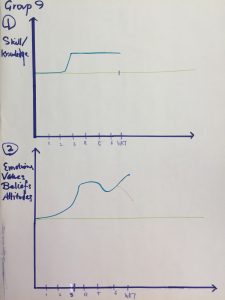Weekly Objectives and Achievements
Objectives
- Begin working on final report and presentation
- Finalize the VFAM Excel Spreadsheet with all correct information
- Compile results from Map Trialing and begin to work on feedback
Achievements
- Updated VFAM map tool Excel Spreadsheet with current contact information for a number of assets as found online
- Reached out to new assets that may be added to the map tool
- Met deadlines for all assignments, including blog posts, project proposals
- Attended the Community Member Map Trailing at Bridge Clinic on March 6
Moment of Significant Change

Description:
During the Moment of Significant Change workshop, we as a group identified the knowledge and skills we have gained so far as and changes in our personal emotions, values, and beliefs throughout the course of this project. The first graph above is the combined graph represented the whole group. We felt our knowledge was relatively low coming to the project. It was not until the orientation session led by our community partner that we got introduced to this ongoing project and received clarifications on our role. Although not shown on the graph, we expect to keep achieving new skills and knowledge throughout the project. Graph 2 represents the changes in personal feelings and attitude. Our emotions were low and neutral in the beginning since we did not know what to expect for the project with lots of uncertainty and doubts. As we learn more about the project we felt more prepared and excited to contribute in helping food insecurity in our community. However, we were quickly overwhelmed by all the documents that were given to us and confusion also arose with the instructions. Some members kept feeling a loss of direction while other members received positive feedback from updating the food assets.
Reflection:
This workshop gave us an opportunity to share our experiences, stories, and feelings with the group members. In many stages of the project uncertainty always gets in the way of our progress which is normal and expected. The reading from the past weeks suggested that our career as food system professionals will be defined and “characterized by condition of inherent and un-avoidable uncertainty” (Shulman, 2005, p. 18). The real challenge is not the uncertainty itself but how we face it and respond to resolve it. This requires critical thinking, effective communication, and trust in the group members. With the first-hand experience gained in this project, we were able to exercise and examine our abilities to cope with uncertainty which is beneficial in the overall learning experience.
Our perceptions of the food asset map have also changed since the beginning of the project. We believe the map is a powerful tool for but we are unclear about its overall impact on addressing food insecurity. Although we feel the contributions we offer is limited, we are hopeful that with consistent efforts in perfecting the map, it can contribute to the bigger picture in the long run.
Graceful Dismount
As the term comes to an end, our group hopes to continue updating the Vancouver Food Asset List to add onto the map. We will do this by collecting any new data for the map as well as reviewing already existing information to ensure its accuracy. A couple of group members have conducted a map trailing trial with a few community members at Bridge Clinic in East Vancouver through the communication of our contact at Vancouver Coastal Health. During this, we were able to get feedback from community members on different ways to improve the map such as making it available to other cities in the Lower Mainland. We will also assess more evaluations by community members facing food insecurities done during this experience via an ethically designed anonymous evaluation. Moreover, we hope to continue our project through keeping constant communication with group members through our Facebook group to delegate our work equally. This will ensure a fair distribution of work between all group members and improve the quality of work. Finally, as our final task, we will interpret the quantitative and qualitative data to articulate our findings and present it in our final report. We aim to transition smoothly into the final stages of our project at the end of this term and hopefully keep in contact with Vancouver Coastal Health.
Reference
Shulman, L. S. (2005). Pedagogies of uncertainty. Liberal Education, 91(2), 18–25. Retrieved from http://files.eric.ed.gov/fulltext/EJ697350.pdf